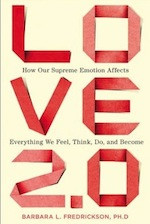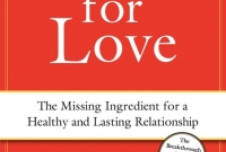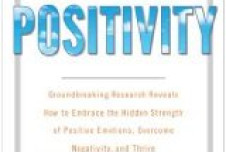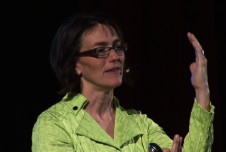Love has been extolled in countless songs and movies. Love is what makes the world go round, a many splendored thing, all you need. But according to Barbara Fredrickson, psychology professor at the University of North Carolina, Chapel Hill, the definition of love needs an upgrade, and she’s written a new book to explain why: Love 2.0: How Our Supreme Emotion Affects Everything We Feel, Think, Do, and Become.
Fredrickson is best known for her “broaden and build theory” of positive emotions. When we experience positive feelings—joy, awe, happiness, etc.—we broaden our awareness of our surroundings and our repertoire of thoughts and actions, which allow help us to build new skills and resources, increasing our resilience and, ultimately, our chances for survival. This theory and its implications were thoroughly explored in her last book, Positivity, where she suggested ways that people could cultivate positive emotion in their lives in order to reap their many benefits.
Here Fredrickson takes a slightly different, albeit related tack, to explore love—what she calls the “supreme emotion.” Unlike other emotions, love, by definition, involves another person, and, according to Fredrickson, our bodies crave it. But, when she writes about love, she isn’t talking about the cultural assumptions of a romantic relationship or familial love or even love between best friends. Instead, she is defining it as the a moment-to-moment experience of warm, mutual caring that we can feel with any person—even strangers—in everyday interactions, something she refers to as “shared positivity.”
According to Fredrickson, love is primarily about connection, and it is important to our health and happiness, affecting our brains and bodies at the cellular level. We were born to love, she writes, and the evidence comes from research that shows how our brains and nervous system were designed to enhance our chances of experiencing it.
For example, research has shown that when we feel connection with another person, our brains tend to “synch up” with each other, not just metaphorically, but physically. Anyone who has been engrossed in conversation with another person knows the feeling of intimacy it can create between two people. Researchers have shown that the brains of people thus engaged are actually firing in the same patterns, in the same parts of the brain, almost simultaneously. This kind of mirroring is likely what creates a “positivity resonance”—shared emotion that can make you feel alive and invigorated.
The hormone oxytocin also plays a crucial role in love. Researchers have found that oxytocin helps people to read social cues better, and to be more generous, altruistic, and self-disclosing, all of which foster trust, an important ingredient in love. Often referred to as the “tend and befriend” hormone for its role in promoting caring behavior, oxytocin is released in the body during positive social encounters, reducing stress, lowering heart-rates and blood pressure, and producing a warm feeling inside. That’s why oxytocin is also connected to sex and breast-feeding—it modulates the bonding that those activities help create. Two people feeling positivity resonance will have synchronized releases of oxytocin, which makes them feel even better about each other.
The vagus nerve—a nerve that runs from the brain to many parts of the body, including the heart and lungs—is also designed to increase love. It plays a role in eye contact and helps you to synchronize facial expressions with another person, both of which aid in connection. It also plays a role in coordinating heart rate and breathing: the more coordinated these are, the better your “vagal tone,” which turns out to have all kinds of health benefits.
Interestingly, all of these internal systems work behind the scenes, beyond our conscious control. Yet, we can tap into them and reap their benefits simply by cultivating more positivity resonance (or love) in our life, and Fredrickson provides ideas on how to do that. Many of her suggestions revolve around using loving kindness mediations—a Buddhist-based practice in which you send out positive wishes to yourself and people in your community, gratitude practices, or conscious focusing of your attention toward positive interactions with others. If practiced regularly, any of these will make a difference in your health, outlook, and relationships, she writes.
Lest this sound too “new age” to you, be prepared to have all of these exercises backed up by scientific evidence of their effectiveness. Fredrickson is, above all, a researcher. She assures her readers that what she is suggesting is “evidence-based” and is meant to increase loving feelings from the inside out, not to make people put on fake smiles or pretend to feel something they don’t. It’s this promise—and the science behind it—that makes Love 2.0 rise above other self help books.








Comments